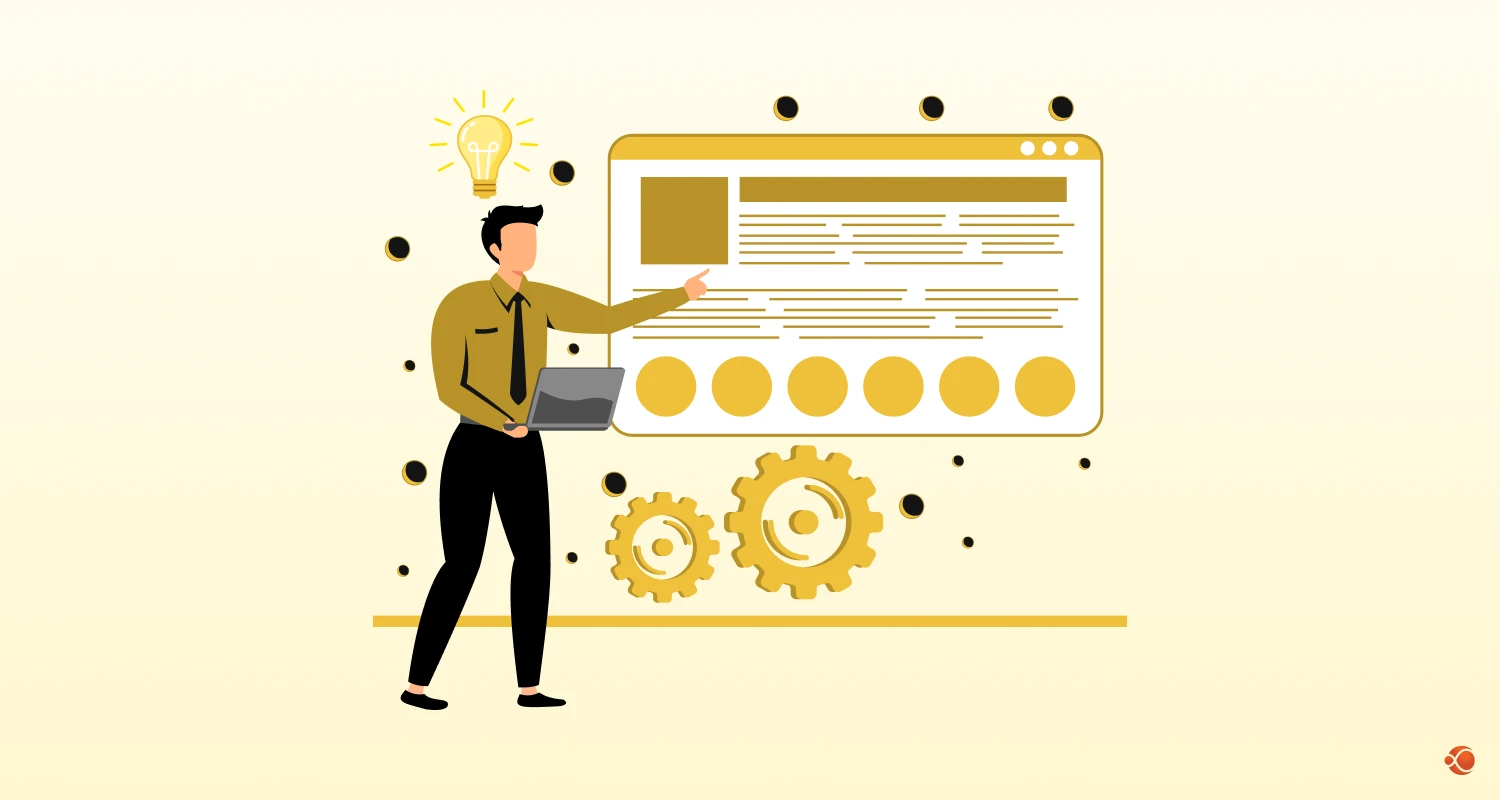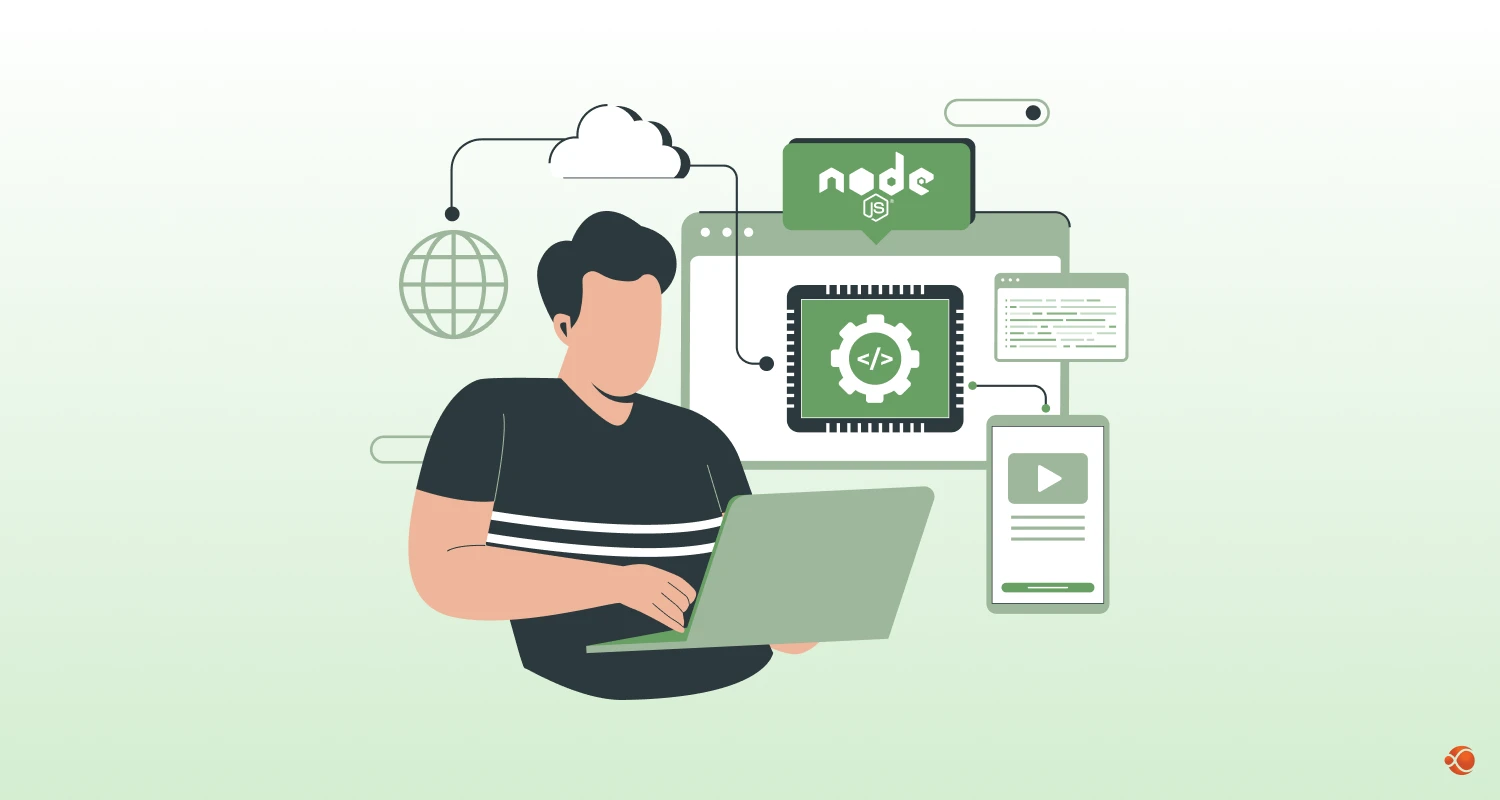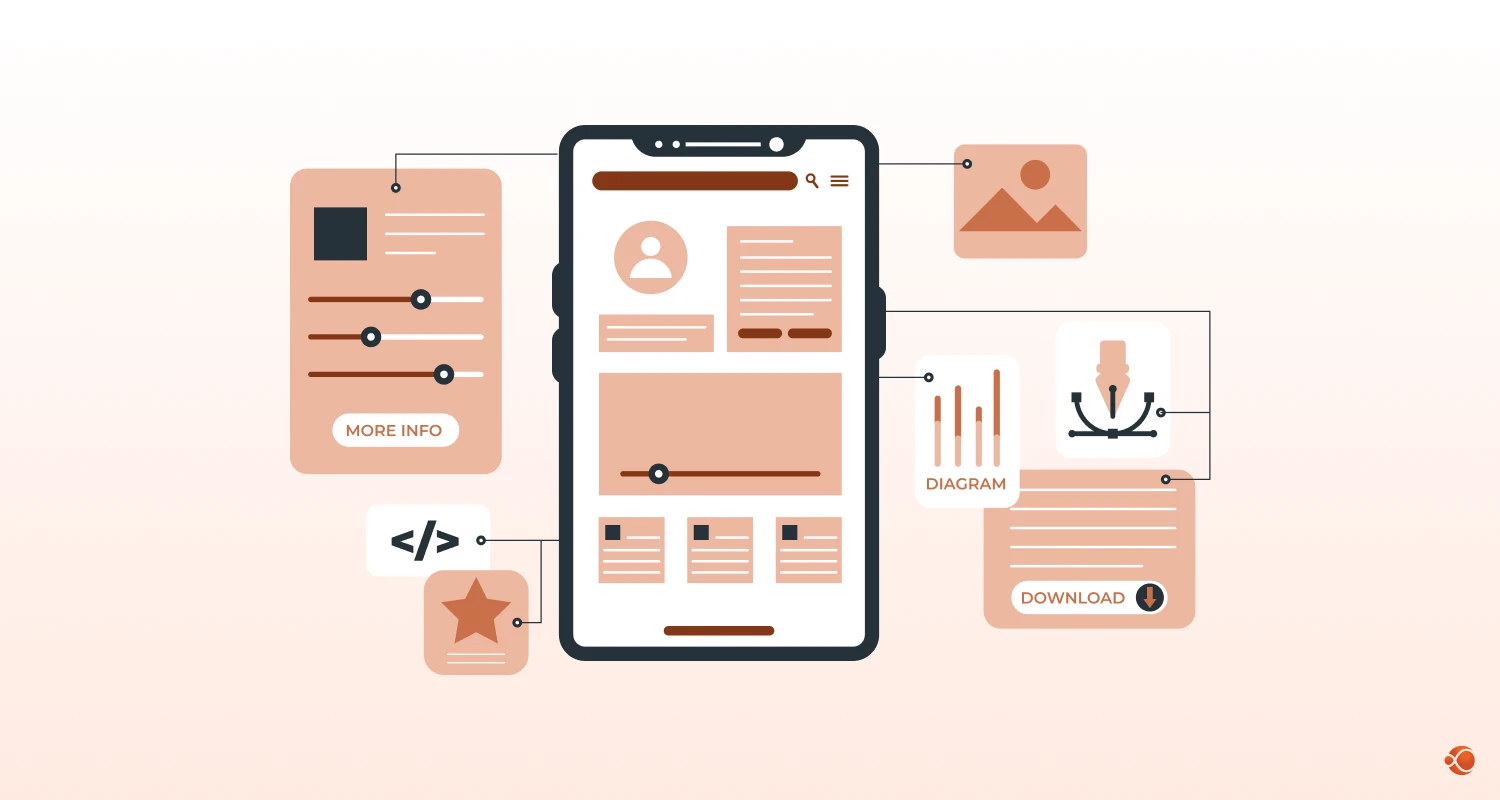Quick Summary: This blog explores how agile development for AI-first SaaS is redefining how software teams build intelligent, learning-based systems. It covers the shift from code-driven features to model-driven experimentation, highlights essential tools and best practices, and shares real-world examples of teams like Netflix and Spotify applying agile in AI-first environments.
Software development teams are building smarter products. Agile methodologies must adapt to handle machine learning models, data pipelines, and AI-powered features. Traditional sprint planning doesn’t work when your “features” are experiments with uncertain outcomes.
Agile AI changes how developers approach product development. Instead of shipping predetermined features, developers run experiments, train models, and iterate based on data. This shift requires new tools, different success metrics, and updated workflows that traditional agile frameworks don’t address.
The global Artificial Intelligence SaaS market size was worth around USD 115.22 billion in 2024 and is predicted to grow to around USD 2,973.14 billion by 2034, with a compound annual growth rate (CAGR) of roughly 38.40% between 2025 and 2034.
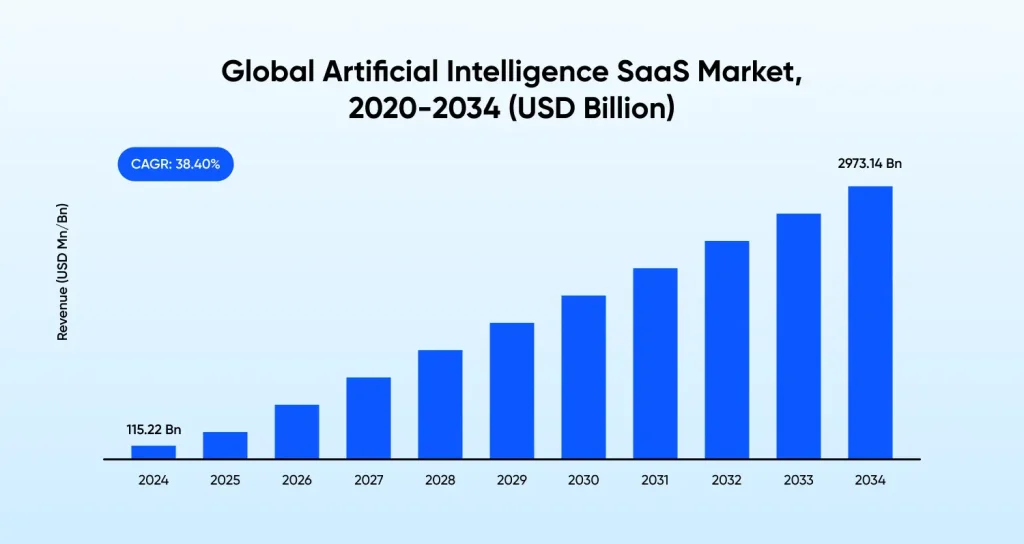
What is AI-first SaaS?
AI-first SaaS development differs from traditional software development approaches. Instead of treating artificial intelligence as an additional feature, these platforms are built around intelligent capabilities from the ground up. The architecture, user experience, and business models revolve around AI-driven value propositions.
Modern SaaS app development services focus on building intelligent systems that learn and adapt, moving beyond static applications to dynamic, self-improving platforms.
Key Characteristics
Model-driven Decision Making
Model-driven decision-making removes the old traditional rule-based logic. Business rules evolve through machine learning rather than manual coding. This creates products that become smarter without constant developers’ intervention.
Data-centric Architecture
This forms the foundation of these structures. Every component is designed to collect, process, and learn from user interactions. The database isn’t stored; it’s a training ground for continuous improvement.
Continuous Learning Loop
They are embedded throughout the journey. Every click, interaction and outcome feeds back into the system, creating a self-improving cycle that traditional software cannot match. This approach allows for integrating machine learning models in SaaS environments through continuous feedback and performance optimization.
Companies like Notion AI, Jasper, and Copy.ai exemplify the approach. Their core value proposition isn’t just soft functionality; it’s intelligent assistance that improves through usage. Nearly half (49%) of technology leaders in PwC’s October 2024 Pulse Survey said that AI is “fully integrated” into a company’s core business strategy.
Iterating with Models: The Fundamental Shift in AI-First Development
The transition from traditional to AI-first development does not confine to adding machine learning features. It fundamentally changes what teams are working on. Traditional software development focuses on the “code commit” as the primary unit of work.
AI-first model flips the script, and introduces a new way of thinking and working. The central unit of work becomes the model iteration. Each new version of the system represents improved intelligence and not just code changes. This shift in thinking demands entirely different thinking about product backlogs, success metrics, and deployment strategies.
Shifting from Feature Backlogs to Hypothesis-Driven Development
Traditional product backlogs focus on user stories like, “As a user, I want a feature to filter my search results by date”. AI-fist backlogs focus on data-driven hypotheses that improve model performance and business outcomes.
The AI Model Iteration Lifecycle
AI-first agile requires a more sophisticated development cycle that accounts for the experimental nature of machine learning. The traditional method used to follow a process of – “Plan → Code → Test → Deploy”. The process now becomes:
1. Hypothesis Formation
Cross-functional teams identify business problems and frame them as testable machine learning hypotheses. Product managers work in close collaboration with data scientists for ensuring alignment between business objectives and technical capabilities.
2. Data Discovery and Feature Engineering
This exploratory phase involves data cleaning, analysis, and feature development. Unlike traditional development, this stage is inherently unpredictable – discoveries often reshape the original hypothesis and reveal new optimization opportunities.
3. Model Experimentation
Teams don’t need to wait to run an experimentation cycle for one model, and then move on to the next. As decision makers and fast-movers, you would prefer being able to deploy parallel experiments. AI model iteration allows you and your team to do just that, with changing algorithms, architectures, and even hyperparameters. You can use automated ML pipelines for faster iterations, and test out various models, all at the same time.
4. Validation and Testing
Successful models undergo rigorous offline testing. They are kept on holdout datasets, a portion of the data that is excluded from the training process of a machine learning model. Teams are able to perform bias detection, fairness audits, and performance validation to ensure models generalize well beyond training data.
5. Production Deployment
A/B testing frameworks help test new AI models against traditional systems, to evaluate real-time performance. Taking a cautious approach like this prevents unexpected performance degradation, while working on the improvements.
6. Continuous Monitoring and Retraining
Deployed models require ongoing performance monitoring to detect drift and degradation. Automated retraining pipelines ensure models adapt to changing user behavior and data patterns.
MLOps: The Infrastructure for Model Iterations
None of this AI development would work without a strong MLOps setup. Just like DevOps helps software teams build and release code faster, MLOps helps AI teams manage and scale their work with smarter automation.
Essential MLOps capabilities include:
- Automated Data Pipelines: Making sure data is always brought in, cleaned, and transformed in a reliable way.
- Experiment Tracking: Keeping a full record of all model experiments, including the settings used and the results.
- Model Registry: Having one place to store and keep track of all versions of trained models
- Continuous Integration for ML: Automatically testing and checking model updates before they go live.
- Performance Monitoring: Constantly checking on how well models are working and the quality of the data in real time.

Agile Principles Reimagined for AI
Traditional agile values require adaptation for implementing artificial intelligence in agile systems. The fundamental principles remain relevant, but their implementation must account for the probabilistic nature of machine learning.
Individual Interactions over Process and Tools
AI developers need deeper collaboration than traditional software teams. Data scientists think in probabilities while developers work in certainties. Product managers must translate business requirements into ML objectives. This value becomes critical when team members speak different technical languages and work with different success criteria.
Responding to Change Over Following a Plan
AI development is more adaptive than responsive, this means you cannot lay out a plan and expect the model to follow it to the dot. It adapts to the data by following algorithms. All machine learning models need to update as per the changing user preferences, business requirements, and shift in data patterns. Static models will render useless in a dynamic environment. For developers that want to build AI SaaS products, the ability to adapt to new data will provide the competitive edge.
Working Software over Comprehensive Documentation
This principle evolves into working models over perfect accuracy. An AI system performing in production provides more value than a theoretically perfect model that never ships. Teams must balance model performance with deployment readiness.
Customer Collaboration over Contract Negotiation
AI development changes this into user feedback over model assumptions. Machine learning models make assumptions about preferences, user behavior, and patterns. These assumptions must be validated through continuous user interaction rather than predetermined requirements.
Top 5 Agile AI Development Tools You Can Use
Agile tools for machine learning go beyond what traditional development environments offer. They’re built to meet the unique needs of AI-first businesses. If you’re planning to hire SaaS developers to build AI SaaS products, make sure they have experience with these agile AI development tools, it’s key to moving fast and building smart.
MLflow
MLflow gives open-source experiment tracking that integrates with most machine learning frameworks. Organizations can log metrics, parameters, and artifacts for every experiment. The platform provides model registry capabilities for version management and deployment tracking.
DVC (Data Version Control)
DVC extends Git functionality to handle large datasets and machine learning models. Developers can version control data files, track changes, and collaborate on datasets without storing large files in Git repositories. DVC works with any cloud storage provider.
BentoML
BentoML simplifies machine learning model deployment with unified serving frameworks. AI developers can package models from any framework into production-ready APIs. The platform supports containerization and deployment to cloud platforms or edge devices.
Kubeflow Pipelines
Kubernetes pipelines allow portable and scalable machine learning workflows on Kubernetes. A developer can build complex ML pipelines with dependency management and parallel execution. The platform gives experiment tracking and pipeline versioning.
Amazon SageMaker
SageMaker gives complete machine learning capabilities, including model training, data preparation, and deployment. The platform provides built-in algorithms and supports custom frameworks. Development engineers can use automated model tuning and multi-model endpoints.
Agile Best Practices for AI SaaS Startups
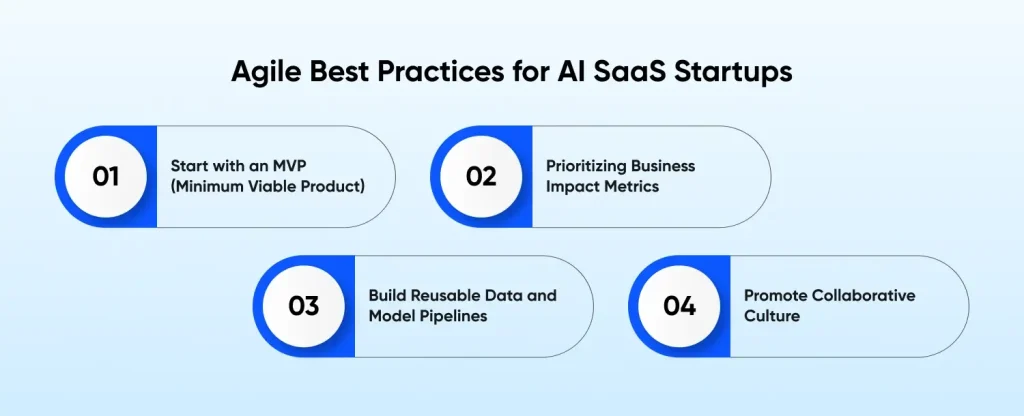
SaaS agile methodology for AI-first products requires specific adaptations that account for resource constraints and rapid scaling needs of startup environments.
Start with an MVP(Minimum Viable Product)
Begin with a simple working model rather than a complete AI solution. A basic recommendation algorithm that works reliably often gives more value than a sophisticated system that fails unpredictably. This approach allows developers to establish a feedback loop quickly and iterate based on real user behavior.
Focus on solving specific user problems rather than building general-purpose AI. Narrow scope reduces the difficulty and increases the chances of early success. The developer can expand capabilities once the main functionality proves valuable.
Prioritizing Business Impact Metrics
Measure success through business outcomes rather than just technical accuracy. This principle helps developers maintain focus on value creation rather than technical perfection.
Create precise success criteria that connect model performance to business objectives. Track metrics like conversion rates, user engagement, and revenue per user alongside traditional ML metrics. This dual tracking makes sure alignment between technical and business goals.
Build Reusable Data and Model Pipelines
Invest in modular, reusable components from day one, since startups cannot afford to rebuild the infrastructure for each new experiment.
Reusable pipelines accelerate the development process and reduce technical debt. This investment pays dividends as the team scales and complexity increases. Design data pipelines that can handle different formats and data sources. Build deployment pipelines that work across multiple algorithms and frameworks. Develop deployment pipelines that support many environments and scaling requirements.
Promote Collaborative Culture
Establish strong communication between developers, product managers, and data scientists. AI development requires constant collaboration between different expertise areas and team members. Regular cross-functional meetings, collaborative tools, and shared documentation become important for success.
Build shared vocabulary and understanding across different teams. Ensure everyone understands how AI components contribute to business value. Implement regular knowledge-sharing sessions, where team members explain their work to colleagues from different departments.
An AI software development company can give the specialized expertise needed to implement these practices, especially for developers transitioning from traditional development approaches.
Real-World Case Studies: Agile in AI-First Teams
Case Study 1: Netflix’s Recommendation Engine Evolution
Netflix provides a compelling example of agile best practices for AI SaaS startups applied to recommendation systems. Over 80% of all viewing activity on Netflix comes from these personalized suggestions, making their recommendations engine important to business success. Its approach is focused on iterative development and continuous experimentation.
Netflix started with a collaborative filtering algorithm and then gradually incorporated more machine learning techniques.
- Weekly A/B testing of different recommendation algorithms
- Continuous model updates based on viewing behavior data
- Cross-functional collaboration among engineers, data scientists, and product teams
- Rapid experimentation cycles to test new features and algorithms
Netflix’s recommendation system now drives the majority of user engagement and has become a key competitive advantage in the streaming market.
Case Study 2: Spotify’s ML-Powered Personalization Platform
The Spotify model is a people-driven, autonomous approach for scaling agile that focuses on culture and network. ML(machine learning) touches every aspect of Spotify’s business, from content discovery to playlist generation.
Spotify’s ML platform shows a successful iteration of machine learning models in SaaS environments. Their approach includes:
- End-to-end ML workflow integration using their custom ML Platform
- Autonomous squad-based development allows quick iteration
- Continuous deployment of ML models with built-in monitoring
- Data-driven decision making across all product features
The platform’s model iteration capabilities allow Spotify to continuously refine its recommendation algorithms based on user behavior patterns and listening preferences.
Since the beginning, our ambition for Spotify’s ML platform has been to connect the end-to-end user journey for ML practitioners. Spotify’s approach helps in scaling machine learning capabilities across multiple teams while maintaining consistency and quality.
Traditional Agile vs Agile AI: A Comprehensive Comparison
Understanding the difference between agile AI development and traditional agile helps developer adapt their processes.
The Future: AI in Agile and DevOps Workflows
AI in agile project management is evolving beyond just building AI products; it’s about using artificial intelligence to improve development processes themselves. The DevOps agile development cycle is being transformed by intelligent automation and predictive analytics.
Predictive Project Management
Predictive project management tools analyze historical data to forecast delivery timelines, finding potential loopholes and optimize team allocation. These systems provide information that human project managers might miss, especially in complex AI development projects.
Machine learning algorithms can forecast tasks that are likely to exceed estimates based on historical patterns. Professional AI developers can proactively address potential delays before they impact sprint goals. This predictive capability improves planning accuracy and resource allocation.
Automated Sprint Planning
Automated sprint planning uses machine learning(ML) to analyze team capabilities, historical velocity and task complexity to suggest optimal sprint compositions. This automation reduces planning overhead and improves estimation accuracy.
AI systems can find patterns in suggested task assignments and team performance that maximize productivity. They can also predict the impact of different sprint compositions on delivery quality and team velocity. This intelligence helps improve collaboration among developers to make well-planned decisions.
Intelligent Testing Platforms
These days the testing platforms are also making use of AI for finding high-risk code changes, predicting potential failures, and improving overall test coverage. This is important for AI systems, as traditional testing methods might be sufficient for proper AI-model testing.
AI-powered testing can automatically generate test cases based on historical failure patterns and code changes. These systems can prioritize testing efforts based on risk assessment and business impact. This targeted method improves testing efficiency and effectiveness.
AI-Powered DevOps
AI powered DevOps introduces anomaly detection for predictive maintenance, infrastructure monitoring and intelligent resource allocation. Such capabilities are important for AI first SaaS products that require scalable infrastructure.
AI systems can improve resource allocation based on the usage patterns and cost contraints. Automated infrastructure management can predict and prevent performance issues before they affect users. This automation improves system reliability and reduces operational overhead.
Future Project Management Evolution
The future of project management with AI includes self-organizing teams supported by intelligent assistants that handle routine tasks, allow human team members to focus on strategic decisions, provide data-driven insights, and creative problem-solving.
Why Choose CMARIX for AI-First SaaS Development?
CMARIX combines deep technical expertise with proven agile methodologies to deliver AI-powered SaaS solutions that scale. Our cross-functional teams include ML engineers, data scientists, and seasoned developers, who understand both traditional software development and AI workflows.
We implement end-to-end MLOps pipelines, make continuous training processes, and develop intelligent systems that learn from user interactions. With experience across industries and a track record of successful AI implementations, CMARIX transforms your vision into intelligent, self-improving software that delivers measurable business value.
Final Words
Agile development for AI-first SaaS represents a fundamental evolution in how we build intelligent software systems. The traditional agile framework gives a solid foundation, but teams must adapt their practices to accommodate the experimental nature of AI development, the complexity of model lifecycle management, and the continuous learning requirements of intelligent systems. The success of the new approach requires more than just adopting new tools; it demands a cultural shift towards continuous learning, experimentation and cross functional collaboration.
Developers who master these principles will build products that don’t just meet user needs, anticipate and evolve with them.
The future belongs to businesses that can smoothly blend human creativity with AI capabilities. By adopting AI-powered MVP development services and modern development practices, SaaS developers can build products that learn, adapt and improve automatically, giving unparalleled value to users and a sustainable competitive advantage for businesses.
FAQs for AI-first SaaS
What Is AI-First SaaS Development?
AI-first SaaS development builds products around intelligent capabilities from the ground up, rather than treating AI as an add-on feature. The architecture, business model, and user experience all revolve around AI-driven value propositions, creating data-centric systems with continuous learning loops.
How Is Agile Development Applied To AI Projects?
Agile AI development focuses on experiment-driven sprints and model versioning strategies. Developers can run experiments to test assumptions about model performance, prioritizing research questions alongside user stories. And implement a CI/CT/CD pipeline that includes continuous training capabilities.
What Makes Agile Development For AI Different From Traditional SaaS?
Agile AI focuses on probabilistic outcomes over binary success metrics, experiment-based planning over feature-driven development, and continuous model training over static deployment. It requires specialized tools for model versioning, performance monitoring, and data management that traditional agile doesn’t address.
Can Agile Principles Help Reduce AI Bias And Improve Performance?
Yes, agile principles promote continuous testing, interactive improvement, and user feedback integration, all of which are important for finding and addressing AI bias. Regular retrospectives, data-driven decision making, and different team collaboration for detecting bias early and implementing corrective measures throughout the development cycle.





